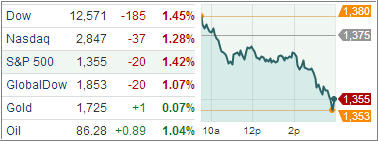Equities finished sharply lower Wednesday to extend losses into the third straight session this week, as major averages fell to multi-month lows over concerns about the upcoming budget debate. Markets turned jittery on news of conflict between Israel and Palestine, wiping out an early tech-driven rally.
Stocks were on the decline after Egypt recalled its ambassador to Israel, and President Obama reiterated his opposition on extending Bush-era tax cuts for rich Americans before meeting top CEOs at the White House.
Obama said the fiscal cliff can be solved, adding the burden on balancing the national budget should not be borne by the middle-class. Investors were also concerned over fresh violence in the Middle East where an Israeli airstrike killed a Hamas military leader that stoked fears of an oil-supply shock.
Reversing an early gain of 0.4 percent, the Dow Jones Industrial Average (DJIA) finished 185 points lower, its lowest least since June 8. Breadth within the benchmark turned overly negative with all but one of the 30 components finishing lower for the day.
The S&P 500 Index (SPX) slipped 20 points with industrials faring the worst and all the 10 business sectors finishing lower. The index has shed more than five percent since President Obama’s reelection of November 6 and is now down about 7.5 percent from its near five-year high on September 14.
Hitting a five-month low, the NASDAQ Composite Index (COMP) trimmed 37 points. The tech-heavy index is now down more than 10 percent from its September high, putting it in what is known as the correction territory.
Treasury prices pushed up modestly to post its fifth straight up session after minutes from the Fed’s latest FOMC meeting showed policy makers supported continued expansion of the central bank’s assets purchase program once the so-called Operation Twist program ends in December.
Yield on the benchmark 10-year Treasury notes was little changed at 1.59 percent while yield on 30-year Treasury bonds dropped one basis point to 2.72 percent.
The dollar surged ahead for the day, reversing early losses after comments from President Obama intensified worries about politicians’ ability to keep the economy from going over the fiscal cliff. The ICE dollar index, a measure for the US unit’s strength against a basket of six global currencies, edged up to 81.111 from 81.097.
European shares, meanwhile, came under pressure Wednesday as anti-austerity protests across southern Europe hit the headlines and worries over US budget negotiations weighed on investors. Industrial production data added to the downbeat mood as September reading fell by 2.5 percent, more than forecast by economists.
The Stoxx Europe 600 index fell 0.9 percent, its lowest level since early September though strong corporate results helped pare losses.
The IBEX 35 index slipped 0.3percent in Madrid after EU Economic and Monetary Affairs Commissioner Olli Rehn said the country may not need to request for bailout officially as the government has allegedly taken enough action to contain the fiscal deficit for 2012 and 2013.
The DAX 30 index tanked 0.9 percent in Frankfurt after Societe Generale downgraded E.ON to hold from buy while the CAC 40 index also shed 0.9 percent in Paris, dragged down by banks Credit Agricole SA and Societe Generale SA.
In the ETF space, oil funds advanced as tension between Israel and Palestine escalated, spurring concerns over potential supply disruptions. The United States Oil Fund (USO) was one of the biggest gainers for the day, adding 1.15 percent as December oil futures rose 1 percent.
The iShares MSCI Israel Capped Investable Market Index Fund was one of the worst performers, shedding 2.52 percent as geopolitical tensions mounted in the Middle East.
As posted earlier, our Trend Tracking Indexes (TTIs) did not yet slide into bear market territory. They are barely hanging on, however, with the Domestic TTI at +0.01% and the International at +0.41%.
Again, I like to see a clear piercing to the downside before declaring that this cycle has come to an end, and we have succumbed to bearish market forces. Until that moment happens, follow your trailing sell stops and execute as necessary.
The crossing of the trend lines to the downside will then be merely confirmation that the bullish trend is over. It’s also a signal that we will be liquidating those equity ETFs that have not yet triggered their respective sell stops.
I will post any trend line crossings as soon as I get all of the day’s data, which is usually by 4 PM PST and will then follow up later on with the commentary.
We are living in extremely uncertain times, and I like to hammer home the point again that it’s absolutely crucial for your financial survival to heed the trailing sell stops and the trend line crossings. Once the first domino in Europe falls (via a country defaulting), the effect on the financial markets worldwide will be enormous with the actual consequences still unknown. So, protect your assets and step aside as per our trading rules.
Sure, the markets can certainly turn around and rally back up leaving you under-invested. Well, I’ll gladly take that chance at this time, because the other side of the equation, jeopardizing your assets in case of a worse than 2008 scenario, is a risk I personally do not want to take.
For quick access to the most recent StatSheet including TTI charts and all momentum figures, click here. You can read the latest ETF Model Portfolio update here.
Disclosure: No holdings in USO
Contact Ulli

